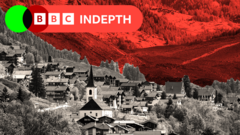In the picturesque Loetschental valley of Switzerland, the effects of climate change have become painfully evident. Just two months ago, a catastrophic landslide destroyed the village of Blatten, relocating its 300 residents. Mayor Matthias Bellwald finds himself overseeing recovery efforts in nearby Wiler, where many residents now reside in temporary accommodations. The sights of Blatten—homes, churches, and cherished memories—have vanished, buried beneath rock, mud, and ice.
Lukas Kalbermatten, whose family operated a hotel there for generations, mourns not only the loss of his home but also the culture and community that shaped his childhood. Rebuilding efforts in Blatten are projected to cost hundreds of millions of dollars, raising new questions about whether the financial commitment is justified. While generous public donations flooded in to support those affected, lingering doubts surrounding the value of reconstructing at-risk villages cloud the future.
The recent disaster has sparked discussions about the broader trend of climate-induced geological instability throughout Switzerland. According to climate scientists, melting glaciers and permafrost are raising the risk of landslides across the mountainous landscape. The Swiss government currently invests approximately $500 million annually on protective measures, yet experts warn that true safeguards could demand far greater expenditure.
The dangers facing Blatten have prompted some Swiss citizens to reflect on their attachment to traditional alpine life and the sustainability of such communities amid increasing natural threats. Public opinion is clearly divided; many Swiss cherish their alpine heritage and landscapes while grappling with the substantial costs of protection and recovery.
Similar patterns of evacuation and relocation are unfolding in other regions, such as Brienz, where heightened geological risks forced residents to abandon their homes. The unpredictability of climate conditions raises persistent concerns about the resilience of Switzerland’s alpine villages.
Cultural identity is also at stake; losing villages like Blatten risks erasing centuries-old traditions, including unique local practices. As sentiments of belonging intertwine with the challenge of rising natural hazards, Swiss citizens face tough decisions about the financial and emotional investments needed to preserve their cherished heritage.
Experts, including glaciologists monitoring retreating ice, underscore the urgent need to address climate change impacts, as diminishing glaciers can disrupt localized economies and lifestyles, leaving communities vulnerable. Amid these challenges, the broader dialogue on sustainable responses to climate-induced catastrophes is gaining urgency.
In cafes across the region, individuals impacted by the disaster gather to share their stories and mourn their losses, all while contemplating the future of their beloved alpine homes. As conversations around evacuation and rebuilding continue, the resilience and spirit of the communities shine through, underscoring the importance of cultural connections that unite them against the backdrop of nature's unpredictable landscape.
Lukas Kalbermatten, whose family operated a hotel there for generations, mourns not only the loss of his home but also the culture and community that shaped his childhood. Rebuilding efforts in Blatten are projected to cost hundreds of millions of dollars, raising new questions about whether the financial commitment is justified. While generous public donations flooded in to support those affected, lingering doubts surrounding the value of reconstructing at-risk villages cloud the future.
The recent disaster has sparked discussions about the broader trend of climate-induced geological instability throughout Switzerland. According to climate scientists, melting glaciers and permafrost are raising the risk of landslides across the mountainous landscape. The Swiss government currently invests approximately $500 million annually on protective measures, yet experts warn that true safeguards could demand far greater expenditure.
The dangers facing Blatten have prompted some Swiss citizens to reflect on their attachment to traditional alpine life and the sustainability of such communities amid increasing natural threats. Public opinion is clearly divided; many Swiss cherish their alpine heritage and landscapes while grappling with the substantial costs of protection and recovery.
Similar patterns of evacuation and relocation are unfolding in other regions, such as Brienz, where heightened geological risks forced residents to abandon their homes. The unpredictability of climate conditions raises persistent concerns about the resilience of Switzerland’s alpine villages.
Cultural identity is also at stake; losing villages like Blatten risks erasing centuries-old traditions, including unique local practices. As sentiments of belonging intertwine with the challenge of rising natural hazards, Swiss citizens face tough decisions about the financial and emotional investments needed to preserve their cherished heritage.
Experts, including glaciologists monitoring retreating ice, underscore the urgent need to address climate change impacts, as diminishing glaciers can disrupt localized economies and lifestyles, leaving communities vulnerable. Amid these challenges, the broader dialogue on sustainable responses to climate-induced catastrophes is gaining urgency.
In cafes across the region, individuals impacted by the disaster gather to share their stories and mourn their losses, all while contemplating the future of their beloved alpine homes. As conversations around evacuation and rebuilding continue, the resilience and spirit of the communities shine through, underscoring the importance of cultural connections that unite them against the backdrop of nature's unpredictable landscape.



















